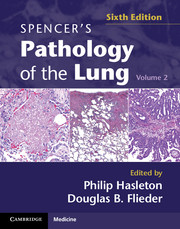Book contents
- Frontmatter
- Dedication
- Contents
- Contents
- Contributors
- Foreword to the First Edition
- Preface to the Sixth Edition
- Acknowledgements
- Chapter 1 The normal lung: histology, embryology, development, aging and function
- Chapter 2 Lung specimen handling and practical considerations
- Chapter 3 Congenital abnormalities and pediatric lung diseases, including neoplasms
- Chapter 4 Pulmonary bacterial infections
- Chapter 5 Pulmonary viral infections
- Chapter 6 Pulmonary mycobacterial infections
- Chapter 7 Pulmonary mycotic infections
- Chapter 8 Pulmonary parasitic infections
- Chapter 9 Acute lung injury
- Chapter 10 Interstitial lung diseases
- Chapter 11 Metabolic and inherited connective tissue disorders involving the lung
- Chapter 12 Hypersensitivity pneumonitis
- Chapter 13 Sarcoidosis
- Chapter 14 Occupational lung disease
- Chapter 15 Eosinophilic lung disease
- Chapter 16 Drug- and therapy-induced lung injury
- Chapter 17 Chronic obstructive pulmonary disease and diseases of the airways
- Chapter 18 Pulmonary vascular pathology
- Chapter 19 Pulmonary vasculitis and pulmonary hemorrhage syndromes
- Chapter 20 The pathology of lung transplantation
- Chapter 21 The lungs in connective tissue disease
- Chapter 22 Benign epithelial neoplasms and tumor-like proliferations of the lung
- Chapter 23 Pulmonary pre-invasive disease
- Chapter 24 Epidemiological and clinical aspects of lung cancer
- Chapter 25 Lung cancer staging
- Chapter 26 Immunohistochemistry in the diagnosis of pulmonary tumors
- Chapter 27 Adenocarcinoma of the lung
- Chapter 28 Squamous cell carcinoma of the lung
- Chapter 29 Large cell carcinoma and adenosquamous carcinoma of the lung
- Chapter 30 Salivary gland neoplasms of the lung
- Chapter 31 Neuroendocrine tumors and other neuroendocrine proliferations of the lung
- Chapter 32 Sarcomatoid carcinomas and variants
- Chapter 33 Mesenchymal and miscellaneous neoplasms
- Chapter 34 Pulmonary lymphoproliferative diseases
- Chapter 35 Metastases involving the lungs
- Chapter 36 Diseases of the pleura
- Index
- References
Chapter 27 - Adenocarcinoma of the lung
Published online by Cambridge University Press: 05 June 2014
- Frontmatter
- Dedication
- Contents
- Contents
- Contributors
- Foreword to the First Edition
- Preface to the Sixth Edition
- Acknowledgements
- Chapter 1 The normal lung: histology, embryology, development, aging and function
- Chapter 2 Lung specimen handling and practical considerations
- Chapter 3 Congenital abnormalities and pediatric lung diseases, including neoplasms
- Chapter 4 Pulmonary bacterial infections
- Chapter 5 Pulmonary viral infections
- Chapter 6 Pulmonary mycobacterial infections
- Chapter 7 Pulmonary mycotic infections
- Chapter 8 Pulmonary parasitic infections
- Chapter 9 Acute lung injury
- Chapter 10 Interstitial lung diseases
- Chapter 11 Metabolic and inherited connective tissue disorders involving the lung
- Chapter 12 Hypersensitivity pneumonitis
- Chapter 13 Sarcoidosis
- Chapter 14 Occupational lung disease
- Chapter 15 Eosinophilic lung disease
- Chapter 16 Drug- and therapy-induced lung injury
- Chapter 17 Chronic obstructive pulmonary disease and diseases of the airways
- Chapter 18 Pulmonary vascular pathology
- Chapter 19 Pulmonary vasculitis and pulmonary hemorrhage syndromes
- Chapter 20 The pathology of lung transplantation
- Chapter 21 The lungs in connective tissue disease
- Chapter 22 Benign epithelial neoplasms and tumor-like proliferations of the lung
- Chapter 23 Pulmonary pre-invasive disease
- Chapter 24 Epidemiological and clinical aspects of lung cancer
- Chapter 25 Lung cancer staging
- Chapter 26 Immunohistochemistry in the diagnosis of pulmonary tumors
- Chapter 27 Adenocarcinoma of the lung
- Chapter 28 Squamous cell carcinoma of the lung
- Chapter 29 Large cell carcinoma and adenosquamous carcinoma of the lung
- Chapter 30 Salivary gland neoplasms of the lung
- Chapter 31 Neuroendocrine tumors and other neuroendocrine proliferations of the lung
- Chapter 32 Sarcomatoid carcinomas and variants
- Chapter 33 Mesenchymal and miscellaneous neoplasms
- Chapter 34 Pulmonary lymphoproliferative diseases
- Chapter 35 Metastases involving the lungs
- Chapter 36 Diseases of the pleura
- Index
- References
Summary
Introduction
Adenocarcinoma is the commonest histological subtype of lung cancer in most of the world and accounts for almost half of all lung cancers. Over the past 20 years it has become clear that this general category of carcinoma is not nearly as monolithic as once thought. Major advances in epidemiological, radiological, histological, immunohistochemical and molecular research paint a very complex picture. These suggest a wide spectrum of different entities, when viewed from different perspectives. All agree, however, that adenocarcinoma is a malignant epithelial tumor with glandular differentiation and/or mucin production. In light of recent therapeutic advances affecting particular subgroups of adenocarcinoma, histopathologists must be aware of subtle morphological and molecular distinctions. This chapter aims to present the current level of understanding within our traditional morphological framework.
Classification and cell of origin
Tumor classifications dating back to the first World Health Organization in 1967 and progressing through to the 2004 document were conceived by and for pathologists to ensure uniform tumor reporting and to aid clinical trials. Adenocarcinoma subclassification was expanded from three entities in 1967 to five major subtypes and five variants in 2004 (Table 1). This development illustrates increased interest in this tumor and the deluge of information shaping our understanding of the carcinoma. The 2004 classification was the first to include relevant clinical and genetic information.
- Type
- Chapter
- Information
- Spencer's Pathology of the Lung , pp. 1043 - 1092Publisher: Cambridge University PressPrint publication year: 2000
References
- 1
- Cited by



